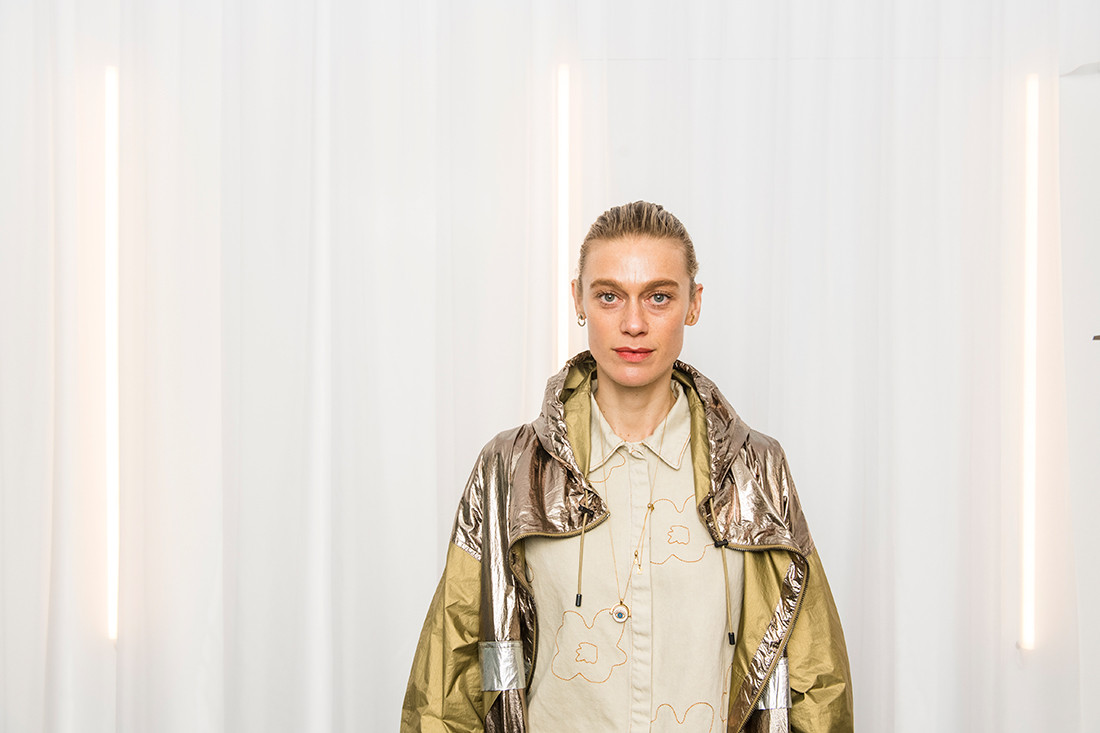Pushing boundaries and fusing the philosophical with the physical – Lucy McRae has carved out an utterly unique body of work (pun intended) that has a firm eye on the future. We talk with the ‘body architect’ ahead of her first retrospective show, now open in Melbourne.
September 5th, 2019
The work of Australian-born, LA-Based artist Lucy McRae presents dysmorphic figures and poses questions for the future evolution of humankind. They are ideas conjured into reality with powerful impact. It seems fitting then that her recently opened retrospective at NGV Australia has created the perfect moment for pause and reflection on a career spanning 13 years.

Lucy McRae, artist and designer, inside ‘Lucy McRae: Body Architect’ at The Ian Potter Centre NGV Australia. Photo by Eugene Hyland.
“It’s really emotional because I’m not only absorbing the arrangement of the work in the space, but I’m also reflecting on how I was feeling when I was making the work. For some of the earlier stuff there is a sense of being out of my depth, which perhaps informs the emotions that I’m experiencing now reflecting back on it,” says McRae.
Tapping into the uncomfortable is a method in McRae’s arsenal of creation, “Working with uncertainty is one of the best ways to stay relevant.” But living or working with “uncertainty” is inherently difficult to do. It’s human nature, and an incredibly ingrained behaviour of our time, to simply shy away from things that are too hard. “People do tend to gravitate towards things that are more certain. But I know that the magic comes when I’m out of my comfort zone,” explains McRae.
An equally important trait that McRae brings to everything she does is risk-taking, delivered with an unabashed fear of failure – another one of those modern aversions that McRae has found a way to effortlessly lean into. “Through enquiry and failing, and desperately wanting to find a breakthrough – that’s where incredible things happen. I’m dissatisfied working within constraints. My work is all risk-taking and the unknown, you have to embrace failure and the fact that everything might not come together,” shares the artist.

Installation view of ‘Lucy McRae: Body Architect’ at The Ian Potter Centre: NGV Australia. Photo by Tom Ross.
Distilling her approach down for how designers might stay a step ahead, the artist comes back to science and the potential for it to coalesce with art and design. Hypothesizing on how these different worlds might come together, she says: “We live in a world where we can design life from scratch. Science is moving way faster than we can keep up with. Faster than the world that supports it. I think that combining imagination with the scientific process will allow us to really be sure about the decisions we’re making. Otherwise, all of those decisions around ethics and science and technology are being left to engineers and a very specific mindset, which is very different to the minds of architects, artists and designers.”
On the surface, McRae’s work is science-focused and technologically-driven, which for designers or architects may seem irrelevant. But delve below the bells and whistles and there is a deeper meaning that speaks to human nature and perhaps what’s around the corner for civilization. It’s in this place that her genius comes to the foreground. “We are so uncertain about the future. So to practice being uncomfortable and to come from a place that is so uncertain is really the only way to move into the future,” adds McRae.

‘Prepping the body for space vol. 2’ 2014 still from colour digital video, commissioning agent Allure, Moscow.
McRae’s underlying drive and energy come from what’s next, as she poetically summarises: “Contentment is a moment in time. It’s a breath.” By questioning, risk-taking and learning to be okay with uncertainty, design can take a leaf out of McRae’s book and start pushing into the great unknown.
How will our bodies inhabit the space around us in the future? Perhaps that’s a question the next generation of designers can answer together with scientists.
Lucy McRae: Body Architect is running at NGV Australia until February 2020.
–
See more stories about What design can learn from here.
A searchable and comprehensive guide for specifying leading products and their suppliers
Keep up to date with the latest and greatest from our industry BFF's!

BLANCO launches their latest finish for a sleek kitchen feel.

With the exceptional 200 Series Fridge Freezer, Gaggenau once again transforms the simple, everyday act of food preservation into an extraordinary, creative and sensory experience, turning the kitchen space into an inspiring culinary atelier.

Elevate any space with statement lighting to illuminate and inspire.

In this candid interview, the culinary mastermind behind Singapore’s Nouri and Appetite talks about food as an act of human connection that transcends borders and accolades, the crucial role of technology in preserving its unifying power, and finding a kindred spirit in Gaggenau’s reverence for tradition and relentless pursuit of innovation.

Elana Castle looks through her design lens at two of the stellar installations from this year’s extraordinary burn.

In a new exhibition, the work of Broached Commissions is put on display for Design Storytellers at the NGV’s Ian Potter Centre.
The internet never sleeps! Here's the stuff you might have missed

Knoll’s revolutionary legacy, from its pioneering mid-century modern origins to its current place within the MillerKnoll collective, continues to shape the spaces we inhabit. Here, we explore the iconic institutions, influential collaborations, and groundbreaking ideas that have shaped Knoll’s unique understanding of the human-space connection — the bedrock of the brand’s enduring relevance.

New forms and patterns have taken shape in the latest acoustic panels from Woven Image – bringing together cutting-edge design to create an immersive, sensorial product.